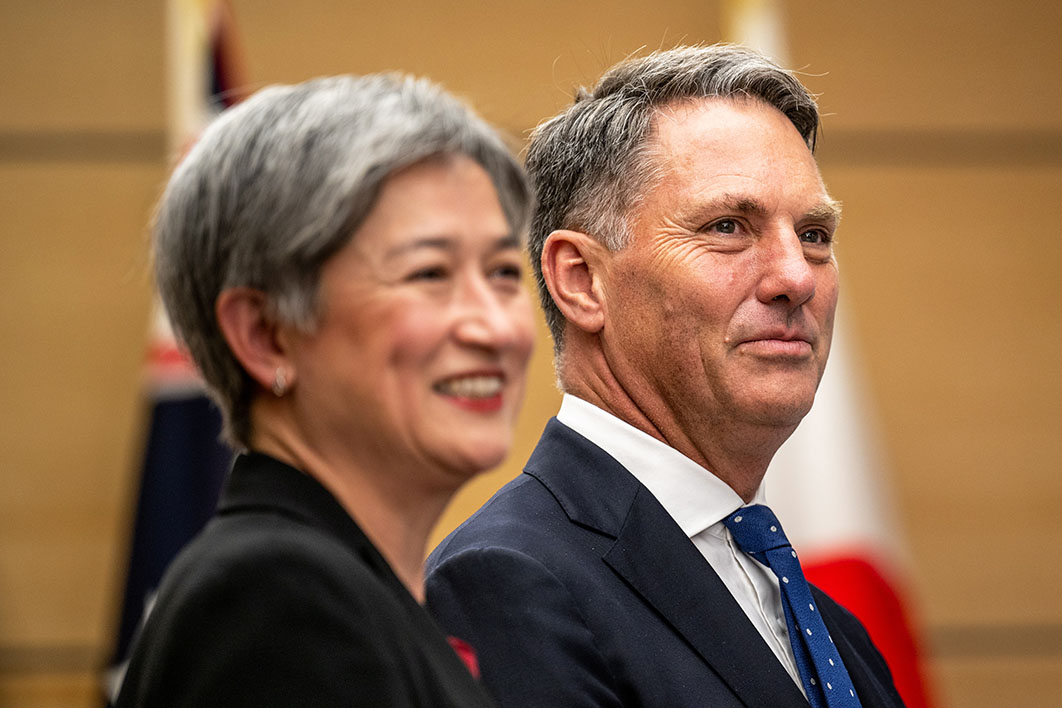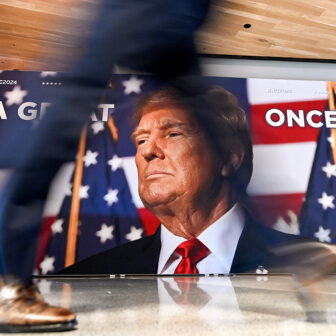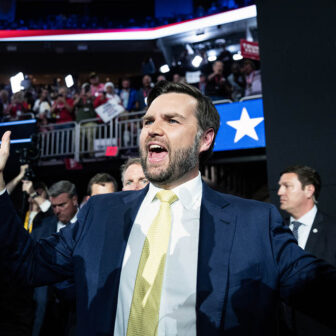Scott Morrison didn’t end last year well: blamed by his own party for its election loss; censured by parliament for his secret ministries; twisting and turning in the witness box at the robodebt royal commission. But in one supreme sphere of government he remains a prophet, with prime minister Anthony Albanese and defence minister Richard Marles his chief disciples, backed by a supporting cast of defence and intelligence officials and security pundits.
The tripartite pact known as AUKUS grew out of a Morrison brainwave some six months after he won what seemed an unwinnable election virtually single-handedly. Under the agreement, Australia is to acquire — and even build — eight US- or British-designed nuclear-powered submarines, known as SSNs.
According to senior political correspondents Peter Hartcher and Paul Kelly, Morrison started asking his officials about possible alternatives to the contentious contract with France’s Naval Group to build twelve Shortfin Barracuda-class conventional submarines in Adelaide. Not long after, in March 2020, he asked defence secretary Greg Moriarty to prepare an options paper, which was delivered two weeks later. Then, in May of that year, he asked Moriarty and defence force chief Angus Campbell to form a group to weigh up the nuclear-power option. Headed by then navy chief Michael Noonan, the group worked in a tight security bubble.
Efforts continued to try to resolve differences with Naval Group over the cost and local content of the French submarines. No one seems to have considered asking the French about the nuclear option, yet the Shortfin Barracuda was a special conventionally powered version of the Barracuda nuclear-powered attack submarine and the Americans had agreed to fit it with their most advanced war-fighting electronics.
One problem was the fact that the reactors in the French submarines use low-enriched (around 5 per cent) uranium in their fuel rods, which require replacing every ten years. This means fewer problems with the nuclear non-proliferation treaty, but would have meant relying on a foreign power. Without a domestic nuclear industry capable of enriching uranium and fabricating rods, any Barracuda submarine bought by Australia would have to sail to France every decade or else somehow arrange transfer of fuel rods from France.
The Australian team and its political masters were seized by the revelation that current American and British nuclear submarines are fuelled by highly enriched (92 per cent) uranium rods that work for the entire life of the submarine, thirty years. Once built, it was claimed, they could be operated by the Australian navy without recourse to American support. Despite the US and British submarines having operated for many years, that news somehow came as a surprise in Canberra.
So, in February 2021, a visiting Australian naval delegation broached the idea of a British or US purchase with the sea lords of the Royal Navy, who gave it a cautious nod as long as the Americans could be brought on board. Britain’s US-derived reactor technology is the product of a unique transfer of know-how by the United States in 1958.
Next, the Americans were sounded out. The first approach was made by Morrison’s handpicked director-general of the Office of National Intelligence, Andrew Shearer, and Australian ambassador Arthur Sinodinos at the end of April 2021, in a meeting with the Biden administration’s senior adviser on Indo-Pacific affairs, Kurt Campbell. Then, the following month, Morrison’s foreign minister, Marise Payne, met with Biden’s secretary of state, Anthony Blinken, and national security advisor Jake Sullivan.
Another few weeks later, Morrison was a guest at the Group of Seven summit in Cornwall, where he felt able to broach the plan with Biden himself. Strangely, British prime minister Boris Johnson was also at the meeting with Biden. The American president clearly detests Johnson for his role in Brexit and potential reopening of conflict in Northern Ireland, but his presence didn’t queer Morrison’s pitch.
Although Biden stipulated that the nuclear transfer must be a bipartisan exercise on the Australian side, Morrison gave opposition leader Anthony Albanese and his deputy just twelve hours’ notice of the announcement of the tripartite agreement to equip Australia with nuclear-powered submarines and collaborate on futuristic technology. The announcement came in September last year in a video hook-up with Biden and Johnson.
Labor endorsed what became known as the AUKUS pact, no doubt seeing it as an attempted political wedge on Morrison’s part but presumably also trusting it to be a well-thought-out response to China’s increasingly confrontational approach and an equally considered lift in Australia’s defence capabilities. After securing government in May last year, though, the Albanese government might have been expected to take a harder look at the AUKUS deal and the SSN component.
There were early signs of such scrutiny. In August, the government appointed former Labor defence and foreign minister Stephen Smith and former defence forces chief Angus Houston to advise on what defence capability Australia needs to meet “the increasingly challenging geostrategic environment.” They were given until March this year to submit their findings (though speculation suggests they’ll report next month) and handed a secret preliminary report to Marles in November.
From hints thrown out by Albanese and Marles, the Smith–Houston review was encouraged to be iconoclastic. In particular, the army’s projected force of 127 heavy Abrams tanks for $2.5 billion and 450 new armoured fighting vehicles at a mooted $27 billion cost — or an average of around $60 million each — seems likely to come into question.
“Our defence assets need to not be about fighting a land war defending western Queensland because that is highly unlikely,” Albanese said in an end-of-year interview with the Nine newspapers, “but a lot of our assets are not really the ones that we necessarily need for this century and for the times — and also their location as well.”
Yet the SSN project seems off-limits. The review’s terms of reference don’t say that explicitly, but Smith and Houston are asked to recommend the “defence posture” needed in 2032–33 and beyond “in light of recently announced large-scale projects.”
This suggests that a parallel defence taskforce, given eighteen months in September 2021 by Morrison to find a pathway to acquiring the SSNs, has proceeded without any fear of being called off.
A defence briefing note describing how the Smith–Houston review relates to the AUKUS submarine project states that it “will help ensure we maximise the potential of this and other AUKUS partnership initiatives in Australia’s best strategic interests.” In other words, defence spending will be trimmed elsewhere if necessary to finance the SSNs, estimated to cost us $200 billion.
Meanwhile, Morrison’s submarine taskforce, with its staff of 360 defence and industry personnel, says it’s on schedule to report to the government in March. (Both it and the final Smith–Houston report are likely to be kept secret.) The SSN taskforce chief, Jonathan Mead, was giving little away in an interview with the Australian’s Cameron Stewart in December. The SSN, he said, would “deliver for Australia a potent war-fighting capability [and help] to deter anyone who may seek to do harm to Australia.”
Mead left a riddle about how the navy can avoid a “capability gap” between likely delivery of the SSNs in the 2040s and 2050s and the retirement of the existing six conventional Collins-class submarines between 2038 and 2046 — assuming that major refits can safely extend the operating life of the Collins boats. Mead said he is focusing only on nuclear submarines, not on stopgap acquisitions of conventional subs.
The capability gap could be even wider if, as British defence minister Ben Wallace and others have suggested, the three AUKUS partners work on a common design for a new generation SSN to replace both the current US Virginia-class and the British Astute-class, each designed in the 1990s and coming towards the end of their production runs.
Mead will also wrestle with the question of local production, which Marles still insists will happen. Ideas floated include building the submarine hulls in Adelaide and then barging them to the United States or Britain for the nuclear reactor to be inserted, or barging the nuclear reactor module with its bomb-grade uranium core to Adelaide. The latter prospect might unsettle some in the City of Churches: when the Astute submarines are fuelled up in Barrow-in-Furness on the west English coast, the local council hands out iodine tablets to residents.
Awaiting the two reports, a clamour of urgency has built up within Canberra’s defence commentariat. Even before last year’s election, Peter Dutton was expressing the hope that the Australian navy could lease one or two Virginia-class SSNs from the US navy to bridge the gap. Having ditched the French, and before them the Japanese, the then defence minister was ready to dump the British.
In November, shadow defence minister Andrew Hastie said Canberra should stop insisting the submarines be built here. Authoritarian powers are “on the move” and it would take too long to start with Australian domestic production, he said. We should try to order two submarines from US yards for delivery by the end of this decade.
But the two US naval yards that build submarines are flat out with orders from the US navy for more Virginia-class SSNs. A letter to Joe Biden in December from two senior US senators argued that adding orders from the Australian navy would stretch American industrial capacity to “breaking point.”
Purchased or leased, the Australian navy won’t have the engineering and command expertise to operate nuclear submarines for many years without importing talent from the US or British navies and arranging maintenance at American or British bases. The submarines will be Australian assets in name only. They will also spend a lot of time undergoing maintenance, and are likely to be available for six-month cruises only fifteen times in their thirty-three-year operational life.
Mixed in with this clamour has been the extension of another Morrison initiative, the 2020 Defence Strategic Update, with its goal of acquiring “more potent capabilities to hold adversary forces and infrastructure at risk further from Australia, including longer-range strike weapons, cyber capabilities and area denial systems.”
Compounding a sense of alarm during Morrison’s prime ministership was the abrupt deterioration in relations with China caused by his call in April 2020 for outside health inspectors to storm into China, invited or not, to find the origins of Covid-19, and the federal police raid on the homes of four journalists with Chinese official media two months later. China responded with trade sanctions to the tune of $20 billion a year and the arrest of Australian journalist Cheng Lei.
With Chinese leader Xi Jinping choosing to wear a military uniform to review huge parades of his armed forces, and Chinese ships and aircraft jostling US forces in nearby seas, it was not hard for defence hawks in Canberra to connect the military build-up and the relationship chill to produce the conclusion: China is a military threat to Australia.
Consequently, Morrison announced a $1 billion scheme to create a domestic missile manufacturing industry to build up ammunition stocks. This quest for greater lethality at longer range has continued under Labor with the planned acquisition of 800-kilometre-range US anti-ship missiles for the air force, 2000-kilometre-range Tomahawk land-attack cruise missiles and Norwegian anti-ship missiles for major navy surface ships and, just recently, twenty US 100- to 300-kilometre-range precision rocket artillery units for the army. The latter, known as HIMARS, have proved a devastatingly effective weapon for Ukraine.
It is unclear whether Canberra intends to acquire its own satellite reconnaissance and targeting systems to direct these missiles, or whether it will rely on American systems.
With multibillion-dollar arms purchases coming thick and fast, defence analysts have thrown off all restraint. A paper last month from the Australian Strategic Policy Institute suggested the air force acquire a squadron of the newly unveiled US air force B-21 bombers. This bat-winged stealth bomber, with its unrefuelled combat radius of 4000 kilometres, could plug the long-range strike capability gap until the SSNs arrive, according to the institute. Still a prototype and yet to be tested in the air, B-21s are likely to cost more than $2 billion each.
Though this thinking was initially presented as a means of hitting any enemy planning to hit Australian assets between 2000 and 3000 kilometres away, and could thus be seen as an extension of the longstanding “Defence of Australia” doctrine, it has morphed in some quarters into a strategy of deterrence: that is, if any enemy thinks it can land blows against Australia it must expect blows in return.
Hence the preference for the larger of the two contending SSNs, America’s Virginia-class, which in its latest version is 10,200 tonnes and can carry up to sixty-five torpedoes, Tomahawk land-attack cruise missiles or other long weapons. Britain’s smaller Astute-class (about 7500 tonnes) carries thirty-six long weapons.
This extra capacity shifts the submarine’s role from denying access to Australian waters to retaliating or attacking. It should be an unsettling thought. Until now, deterrence against a rival superpower was left to the Americans. Are we having doubts about that, just as the South Koreans and perhaps some Japanese are?
And, for China, what kind of deterrence would be offered by the prospect of a couple of submarines coming close to its coast and firing off conventional-explosive-tipped missiles at a score of land targets?
This line of thinking also betrays unease in Canberra about the American nuclear umbrella. In countries anxious about nuclear-armed strategic rivals but without a reliable superpower protector, deterrence thinking goes in one direction, towards an independent nuclear capability: ask India, Pakistan, Iran and Israel.
But the nuclear submarine push is unlikely to be thrown off course by questions about its feasibility — and certainly not by suggestions from defence analysts like Hugh White, Brian Toohey and Clinton Fernandes that smaller and less noisy conventional submarines are a greater threat to enemy navies than nuclear subs, are better suited to operations in the archipelagic waters of Australia’s approaches, and are better matched with our budgetary and industrial capacities.
Nor will the hawks be thrown off course by the equally forlorn thoughts of some in the international relations community, along with figures like Paul Keating, that getting closer to the anglophone powers is a retrograde step. Australian proponents of the American alliance have long claimed that Southeast Asians are secretly pleased by our closeness with the United States and are not fussed about our tightening “interoperability” and now “interchangeability” with US forces. There is not a lot of evidence for this.
Hawkish commentators are thrilled that the stepped-up “rotation” of American forces through northern Australia will make us somehow pivotal to the US posture against China in the South China Sea, the Taiwan Strait and the East China Sea, instead of a rear base to disperse forces away from Chinese attack. Their worry is that things will blow up before we have the SSNs to join in.
Unless Admiral Mead produces a technological surprise out of his braided hat, though, the sheer impracticality of Morrison’s grand scheme may soon become apparent. This may give more scope for foreign minister Penny Wong to work on giving AUKUS a less dominant place in Australia’s strategic position.
Morrison’s AUKUS plan raised “valid questions about Australia’s sovereign capability,” Wong said in a speech to Sydney University’s US Studies Centre a week after the September 2021 announcement. But, she added, “with the prospect of a higher level of technological dependence on the US, how does the Morrison–Joyce government assure Australians that we can act alone when need be; that we have the autonomy to defend ourselves, however and whenever we need to.”
The new pact had to be “additional to” and not “instead of” Australia’s contribution to existing regional architecture, Wong said. “It doesn’t replace the ANZUS alliance, the East Asia Summit, the ASEAN Regional Forum, APEC or the Quad.”
For Wong, Southeast Asia remains a prime focus of Australian national interest. “Our strategic ambitions must be matched by equally ambitious efforts to respond to the region’s needs. This of course requires a bigger investment in our diplomacy, including in our economic engagement and development program. Submarines might help protect the region, but on their own they won’t build the region we want — a region that is stable, prosperous, as well as respectful of sovereignty. And submarines can help our national defence, but won’t of themselves prevent efforts at economic coercion.”
Judging by her round of regional visits and the more low-key tone of dialogue with China, these are surely the kind of thoughts she is expressing within the government. But having so warmly embraced what Paul Kelly has tentatively called the “Morrison doctrine” it may take a while for Albanese and Marles to loosen their attachment to the Anglosphere, return strategic policy to the mainstream represented by the Defence of Australia doctrine, and extricate themselves from what is turning into another Morrison fiasco. •




